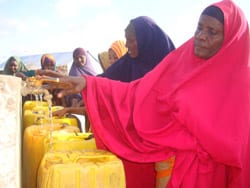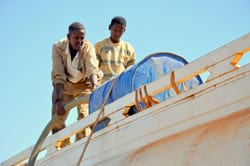Here we present Oxfam’s position on Somalia famine, explaining that the situation in Somalia is a “triple failure” of food production, food access and response. Crop failure and poverty leave people vulnerable to starvation – but famine only occurs with political failure. In Somalia years of internal violence and conflict has been highly significant in creating the conditions for famine.
 |
|
Hawo collects water for her family. Hawo and her six children have taken shelter at Lafole camp, which Oxfam is supporting with clean water and sanitation.
|
Oxfam’s position on Somalia famine
The situation in Somalia is a “triple failure” of:
1. Food production: Where a lack of food does not meet people’s needs as a result of harvest failure or drought
2. Food access: People too poor to afford food, there are rising food prices or no social safety nets
3. Response: Where there’s a lack of political will; donors act too late and there are poor information flows
Crop failure and poverty leave people vulnerable to starvation – but famine only occurs with political failure. In Somalia years of internal violence and conflict has been highly significant in creating the conditions for famine.
Decision-makers have collectively failed to act properly to avert a famine in Somalia and help all those who need food across the Horn of Africa. It is inconceivable that there has been such a catastrophic breakdown of collective responsibility to act, given what was known to be happening over nearly two years.
The UN announcement of famine in Somalia – at a time when famine has been eradicated everywhere else – is both a wake-up call to the scale of this disaster, and a wake-up call to the short- and long-term solutions we need to limit death-from-hunger now and stop it for good in Africa in the future.
What is famine?
The 21st Century is the first time in human history that we have the capacity to eradicate famine. Europe hasn’t had a famine since the 1940s, East Asia since the 1960s, South Asia since the 1970s. But Somalia is not the first mass-scale food crisis in Africa since 2000 – with the 2000 Ethiopia crisis having been the last officially-declared and widely-accepted famine.
The UN uses a five-step scale, developed with NGOs including Oxfam, to assess a country’s food security. In order to be classed as Stage Five, a “famine/humanitarian catastrophe”, a crisis requires:
- malnutrition rates greater than 30%
- mortality rates greater than two per day per 10,000 people
- and food is limited to less than 2,100 kilocalories per day per person
- water is limited to less than four litres a day per person.
 |
|
Water trucks prepare to set off from Burao, A Somali regional capital, to take clean water to the surrounding village .
|
What needs to be done
Humanitarian relief is desperately needed now to save lives. But the fact that we need to appeal again for aid, for a major food crisis for the fourth time in Africa since 2000, reflects the fundamental failure of policy to address the underlying problems in African livelihood systems.
We need money. We need food made accessible to people in the markets, otherwise there will be mass deaths again from hunger in Africa. But we also need to tackle the specific risks that certain African countries consistently face in production, access and response.
Production
We must accelerate investment in African food production. There are regions in Africa we know have always faced chronic food shortages, where even small blips in harvests can have terrible consequences. We need more support for small-holder farmers and pastoralists (e.g. hardier crops, cheaper inputs, disaster risk management).
Access
More aid and investment into physical infrastructure (roads, communications etc) and allowing public intervention to correct market failures until markets are stronger (e.g. grain reserves to stop price volatility).
Response
We need guaranteed social protection such as social assistance to poor households to access food throughout the year and insurances, so that support can be triggered automatically in times of crisis. In some contexts cash transfers can be more appropriate than food aid, where availability of food is not a problem.
Ultimately, famine prevention in Africa rests with African governments – but they need help to rid their countries of conflict and build up democratically responsive, accountable and transparent institutions, and to tackle the fundamental problems of food production, access and response that have been resolved everywhere else in the world bar Africa.
Oxfam is now responding to the East African crisis by providing life-saving water, sanitation services, food, and cash. We aim to reach at least 3 million people, including 700,000 in Ethiopia, 1.3 million in Kenya, and 500,000 in Somalia.
- Have a voice. Join our GROW campaign and let’s share ideas and solutions for a future where everyone has enough to eat, always.
Further reading: Oxfam reports and briefing papers
- Band Aid and Beyond, Oxfam Briefing Paper 22 October 2009
- Why does famine persist in Africa? Devereux, Food Security Vol 1 No 1 Jan 2009
- East Africa Food Crisis, Oxfam Briefing Paper 20 July 2011
- Find out more more about the crisis sweeping across Eastern Africa
Why are millions of people facing starvation? - In pictures: Photostories direct from the Horn of Africa
See what life is like for affected people and Oxfam’s response in our photostories. - Blogs, media clips and videos from the field
Find out what life is like for the millions of people affected by the drought and the latest on Oxfam’s response.



